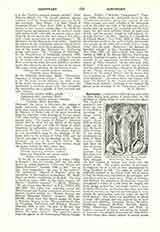

Sanctuary, a consecrated place giving protection to those fleeing from justice or persecution; or, the privilege of taking refuge in such consecrated place. The right of sanctuary was based on the inviolability attaching to things sacred, and not, as some have held, on the example set by the Hebrew cities of refuge. It was recognized under the Code of Theodosius (399) and later by that of Justinian. Papal sanction was first given to it by Leo I, about THE SANCTUARY OF ST. MENAB, EGYPT 460, though Ivory Carving, Museum, Milan the first Council of Orange had dealt with the matter in 441. The earliest mention of sanctuary in England was in a code of laws promulgated by King Ethelbert in 600. The right of asylum was originally confined to the church itself, but in course of time its limits were extended to the precincts, and sometimes even to a larger area. Thus, at Beverley and Hexham, the boundaries of sanctuary extended throughout a radius of a mile from the church, the limits being marked by “sanctuary crosses”, some of which still remain. In Norman times there were two kinds of sanctuary in England, one belonging to every church by prescription and the other by special royal charter. The latter was considered to afford a much safer asylum and was enjoyed by at least twenty-two churches, including Battle, Beverley, Colchester, Durham, Hexham, Norwich, Ripon, Wells, Winchester, Westminster, and York. A fugitive convicted of felony and taking the benefit of sanctuary was afforded protection for from thirty to forty days, after which, subject to certain severe conditions, he had to “abjure the realm”, that is leave the kingdom within a specified time and take an oath not to return without the king’s leave. Violation of the protection of sanctuary was punishable by excommunication. In some cases there was a stone seat within the church, called the “frithstool”, on which it is said the seeker of sanctuary had to sit in order to establish his claim to protection. In others, and more commonly, there was a large ring or knocker on the church door, the holding of which gave the right of asylum. Examples of these may be seen at Durham cathedral, St. Gregory’s, Norwich, and elsewhere. The ecclesiastical right of sanctuary ceased in England at the Reformation, but was after that date allowed to certain non-ecclesiastical precincts, which afforded shelter chiefly to debtors. The houses of ambassadors were also sometimes quasi-sanctuaries. Whitefriars, London (also called Alsatia), was the last place of sanctuary used in England, but it was abolished by Act of Parliament in 1697. In other European countries the right of sanctuary ceased towards the end of the eighteenth century.
G. CYPRIAN ALSTON

